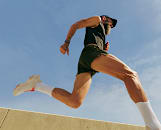
Maskot / DigitalVision via Getty Images
How Exercise Lowers Your Blood Sugar—and Workouts to Try for the Biggest Benefit
Health experts break it all down.
By Kathleen Ferraro•
How Does Exercise Lower Blood Sugar?
Which Workouts Lower Blood Sugar Most Efficiently?
Can Exercise Ever Raise Your Blood Sugar?
How Much Exercise Should You Do to Lower Blood Sugar?
Could the Timing of Your Workout Impact Blood Sugar Levels?
More Factors to Keep In Mind
The Takeaway
Ever feel like you need a nap after a big meal? That might be high blood sugar talking. But here’s the good news: A little movement can bring you back down from that spike. Indeed, exercise does lower your blood sugar, helping you stay sharp and energized instead of sluggish and foggy.
Discover more ways to reach your goals with Peloton
To understand exactly how exercise lowers your blood sugar, it helps to have a quick physiology refresher: Blood sugar (aka glucose) comes from the food you eat and fuels your body, according to the National Library of Medicine. If your blood sugar gets too high, you might feel thirsty, fatigued, or get a headache. If it drops too low, you could get shaky, sweaty, or dizzy. The sweet spot? Blood sugar that’s between 70 and 100 mg/dL before eating can help you feel energized and steady throughout the day, per the World Health Organization.
But keeping your blood sugar in that ideal range isn’t just about what you eat. It’s also about how you move. Physical activity doesn’t just burn off extra sugar—it actually helps your body use the hormone insulin more effectively, keeping your blood sugar levels steadier over time (and helping you dodge those post-meal crashes).
Here’s what the experts say about how exercise affects your blood sugar and how to optimize your fitness routine to keep your glucose levels steady.
How Does Exercise Lower Blood Sugar?
When you move, your muscles need energy, and they tap into glucose from your bloodstream to get it, says Raj Dasgupta, MD, an associate professor of clinical medicine at the University of California, Riverside School of Medicine. “This means less sugar floating around in your bloodstream, which is exactly what you want if you’re trying to keep your levels in check,” he explains.
And that’s not all—exercise also makes your body more sensitive to insulin, says Amerigo Rossi, an exercise physiologist and director of the exercise and sport science MS program at the New York Institute of Technology.
Insulin is a hormone from your pancreas that helps move sugar from your blood into your cells, where it’s used for energy. But if you have insulin resistance (which is the case with conditions like prediabetes and type 2 diabetes), your pancreas can’t produce enough insulin to keep up with the amount of sugar in your blood, according to the Centers for Disease Control and Prevention.
That’s where exercise comes in. Whether you have insulin resistance or not, regular physical activity trains your cells to get better at absorbing glucose rather than leaving it circulating in the blood. This effect kicks in as you move and can continue for hours post-workout—sometimes lowering your blood sugar level for 24 hours or more, according to the American Diabetes Association (ADA). That’s why exercise is a particularly powerful tool for managing conditions like type 2 diabetes.
Which Workouts Lower Blood Sugar Most Efficiently?
Some workouts will affect your blood sugar levels differently than others, Dr. Dasgupta says.
“Both cardio and strength training can help, but in different ways,” he says. “Cardio (like walking, running, or cycling) tends to lower blood sugar more quickly, while strength training helps improve insulin sensitivity over time, leading to longer-lasting benefits. A mix of both is usually the best approach.”
High-intensity interval training (HIIT) is another solid option, Rossi says. HIIT workouts alternate short bursts of intense effort with brief recovery periods, making it a time-efficient way to get both cardio and strength benefits in one session.
If blood sugar control is your goal, Dr. Dasgupta also suggests making movement a regular part of your day beyond structured workouts (think: taking the stairs instead of the escalator or enjoying a post-dinner dance break). “Other tips I recommend to my patients to help lower your blood sugar levels include taking a walk after dinner, integrating low-impact activities, and trying to vary your exercise routine,” he says.
Can Exercise Ever Raise Your Blood Sugar?
Surprisingly, yes: Intense exercise can temporarily increase your blood glucose levels, Dr. Dasgupta says. This happens because strenuous workouts activate the body’s stress response, triggering the release of stress hormones like adrenaline, per the ADA. This prompts the liver to release stored glucose into your bloodstream, providing the energy boost you need to fuel the rest of your activity.
This effect is most common with strenuous activities like:
Heavy lifting
Maximum-effort intervals
Competitive sports
HIIT workouts
While this temporary blood sugar spike might seem counterintuitive, it’s usually nothing to worry about. Your glucose levels should return to baseline as you recover from your workout, and “in the long term, regular intense training will lower blood sugar,” Rossi says. Remember, that’s because consistent physical activity improves insulin sensitivity, which helps lower your baseline blood sugar levels and reduce your risk of insulin resistance over time, according to a 2022 study in Medicina.
If you have diabetes, though, it’s important to approach high-intensity exercise with a bit of extra caution. These workouts require more glucose for fuel, and if you’re using insulin, you may be at risk of hypoglycemia, which is when your blood sugar drops too low, according to the ADA.
But generally, you don’t need to let that stop you from a hard workout. Just be sure to monitor your blood sugar levels. Generally, the ADA recommends having 15–20 grams of carbs every 15 minutes until your blood sugar is at least 100 mg/dL before you start to exercise.
On the flip side of the coin, some pre-workout foods could also contribute to temporary glucose spikes, the ADA notes. Eating high-carb foods like bagels or packaged cereals may provide more glucose than your body can burn off during your workout. If you notice symptoms of high blood sugar after eating despite physical activity, try a lighter snack or foods with more protein and fat in the future.

yacobchuk / iStock / Getty Images Plus via Getty Images
How Much Exercise Should You Do to Lower Blood Sugar?
Experts generally recommend getting at least 150 minutes of moderate-intensity cardio exercise (think brisk walking or cycling) or 75 minutes of vigorous aerobic activity (like running or swimming) per week. On top of that, they also recommend two or more days of strength-focused activities per week (like weight lifting or resistance training), according to the National Institutes of Health.
This recommended minimum is a great place to start when it comes to regulating your blood glucose levels, Dr. Dasgupta says. But if you can increase your activity levels beyond that, you’ll likely see even greater benefits.
“Spreading activity throughout the day (like a walk after meals) and adding some higher-intensity workouts can make an even bigger difference,” he says.
The most important thing to remember, though? Any exercise is better than none, Rossi says.
“For someone who is just starting out, I’d recommend trying to do a little bit more this week than last so that you can build up to the minimum recommendations,” he says. “Once you get to the minimum recommendations, I still promote doing even more exercise. About 300 minutes per week of moderate-intensity exercise is required to lose weight, which can have a very positive effect on people with type 2 diabetes or prediabetes.”
Could the Timing of Your Workout Impact Blood Sugar Levels?
It’s not just about what exercise you do—it’s also about when you do it. Believe it or not, the timing of your workouts can make a difference in how well they help lower your blood sugar in the short term.
Post-meal exercise—especially after bigger meals like dinner—can be a game-changer. When you work out after eating, your body uses the glucose from the meal to fuel your workout, helping prevent those big blood sugar spikes, according to Dr. Dasgupta.
There’s research to back this up: A 2016 review in Scientifica found that exercising 30 minutes after a meal (by doing either an hour of light cardio or 20–30 minutes of moderate cardio) can help keep those blood sugar spikes at bay.
Morning workouts can also be ideal for some. If you have higher insulin resistance after waking up, getting a morning sweat in can actually help boost your insulin sensitivity and lower your blood glucose levels, Dr. Dasgupta says.
However, this effect can vary from person to person. A 2024 study in Obesity found that sedentary adults who were overweight or obese who did moderate- to high-intensity exercise in the evenings were better able to maintain stable blood sugar levels. On the other hand, a 2023 review in Diabetes Spectrum found that people with type 1 diabetes tend to have more stable blood sugar levels when they do light- to moderate-intensity cardio in the morning.
Put simply, there’s no “one-size-fits-all” approach, Dr. Dasgupta says. And really, there’s no such thing as a “bad” time to exercise, Rossi adds.
“It’s more important to work out at a time that works within your schedule and when you feel good,” he says. “That way, you’re more likely to enjoy the workout and develop a consistent routine, which is the key to long-term success.”

Peloton App
Access thousands of classes with no equipment needed.
More Factors to Keep In Mind
If you have diabetes, exercise can be a powerful tool for managing your blood sugar levels and combatting insulin resistance. But it’s important to clear any new fitness routine with your doctor to avoid possible risks, particularly if you have complications from the disease, according to the ADA. Consider, for instance:
Very strenuous activity and heavy lifting can worsen heart disease or high blood pressure.
Strenuous, high-impact, or prolonged weight-bearing activities could aggravate foot injuries, sores, or ulcers from peripheral neuropathy.
Exercising in the heat can lead to fainting for those with autonomic neuropathy.
The Takeaway
Exercise isn’t just good for your heart and muscles—it’s also a powerful tool for keeping your blood sugar in check. Moving your body helps clear extra glucose from your bloodstream and makes your cells more responsive to blood-sugar-regulating insulin over time. Combining cardio and strength training offers the most long-term benefits, but even taking a short walk after eating can help prevent post-meal blood sugar spikes. The best part? You don’t need to hit the gym for hours—consistent movement in any form makes a difference to help you stay energized, focused, and steady throughout the day.
Related Articles
This content is for informational and educational purposes only and does not constitute individualized advice. It is not intended to replace professional medical evaluation, diagnosis, or treatment. Seek the advice of your physician for questions you may have regarding your health or a medical condition. If you are having a medical emergency, call your physician or 911 immediately.
Get our latest health stories straight to your inbox
Enter your email to get articles, expert-backed tips, and updates from Peloton sent to your inbox.
By providing your email address, you agree to receive marketing communications from Peloton.
For more about how we use your information, see our Privacy Policy.













